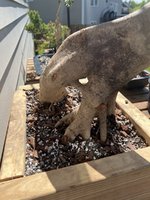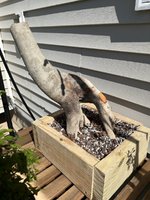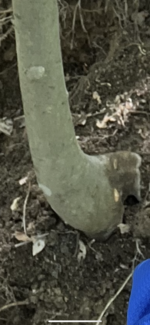99 Mile Creek
Yamadori
I’ve come across a few threads on American beech yamadori. I felt I would be able to give it a try with one from my property. This one came from an area in the side of a mountain that is actively being cut down to allow more sunlight through to the ground floor for growth(part of my whitetail-management plan). I plan to keep as many trees alive as I can. Realistically, I won’t be able to save all the trees in the two areas that will need to be cut back and have some interesting ideas in mind on how to use the trees that do come down. But this came from an area well away from any other beeches so as to avoid collecting a 'sucker.'
My question is on watering and keeping this guy healthy as possible. I had the soil and materials to make a wood frame for it right after digging up.
I’ve made well-draining substrate (fullers earth, perlite ~50/50 mix with pine bark ~10%). It’s almost like pouring water through a screen. It made me uneasy at first. But the science is there. It’s in literature and many bonsai enthusiasts use it. My other trees like it and have responded to it well. Brazilian rain tree took to it in just two days, my most recent repot due to the pot busting.
I typically water my trees once a day on an automatic system. Many reasons why I have it set up, e.g., being away all day, out of town for a few days, vacations. It’s nice to have. I’ve also heard it said you can’t really overwater a bonsai in proper, modern substrate. But I usually turn it off for the day when I make my rounds and am home to monitor the trees. When I notice the moisture is fine due to retaining well or recent rain I don’t water. When it’s reached 80’s or higher I’ll water some of my trees twice. Those in nursery pots and nursery soils get watered every other day or every three to four depending. Spot watering for the most part.
But now I have a larger-than-expected beech in a wooden frame with this substrate. Due to the substrate draining so well, I planned on watering every other day or everyday in the summer. So about half that of normal-growing tree. Just the plan, not a rule. I was hoping for some pointers on how often to water? Anyone with experience with collecting this species? I did seal the chop with some cheap glue. Used a thin layer, hoping to seal in moisture.
My question is on watering and keeping this guy healthy as possible. I had the soil and materials to make a wood frame for it right after digging up.
I’ve made well-draining substrate (fullers earth, perlite ~50/50 mix with pine bark ~10%). It’s almost like pouring water through a screen. It made me uneasy at first. But the science is there. It’s in literature and many bonsai enthusiasts use it. My other trees like it and have responded to it well. Brazilian rain tree took to it in just two days, my most recent repot due to the pot busting.
I typically water my trees once a day on an automatic system. Many reasons why I have it set up, e.g., being away all day, out of town for a few days, vacations. It’s nice to have. I’ve also heard it said you can’t really overwater a bonsai in proper, modern substrate. But I usually turn it off for the day when I make my rounds and am home to monitor the trees. When I notice the moisture is fine due to retaining well or recent rain I don’t water. When it’s reached 80’s or higher I’ll water some of my trees twice. Those in nursery pots and nursery soils get watered every other day or every three to four depending. Spot watering for the most part.
But now I have a larger-than-expected beech in a wooden frame with this substrate. Due to the substrate draining so well, I planned on watering every other day or everyday in the summer. So about half that of normal-growing tree. Just the plan, not a rule. I was hoping for some pointers on how often to water? Anyone with experience with collecting this species? I did seal the chop with some cheap glue. Used a thin layer, hoping to seal in moisture.
Attachments
Last edited:



